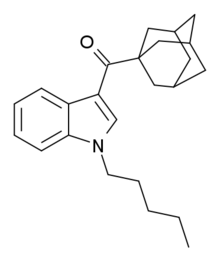AB-001
 | |
| Legal status | |
|---|---|
| Legal status |
|
| Identifiers | |
| |
| CAS Number |
1345973-49-0 |
| PubChem (CID) | 57404070 |
| ChemSpider |
26286891 |
| UNII |
H657DIA015 |
| Chemical and physical data | |
| Formula | C24H31NO |
| Molar mass | 349.508 g/mol |
| 3D model (Jmol) | Interactive image |
| |
| |
| | |
AB-001 or 1-pentyl-3-(1-adamantoyl)indole is a designer drug that was found as an ingredient in synthetic cannabis smoking blends in Ireland in 2010 and Hungary and Germany in 2011.[1][2][3] It is unclear who AB-001 was originally developed by, but it is structurally related to compounds such as AM-1248 and its corresponding 1-(tetrahydropyran-4-ylmethyl) analogue, which are known to be potent cannabinoid agonists with moderate to high selectivity for CB2 over CB1.[4][5] The first published synthesis and pharmacological evaluation of AB-001 revealed that it acts as a full agonist at CB1 (EC50 = 35 nM) and CB2 receptors (EC50 = 48 nM).[6] However, AB-001 was found to possess only weak cannabimimetic effects in rats at doses up to 30 mg/kg, making it less potent than the carboxamide analogue APICA, which possesses potent cannabimimetic activity at doses of 3 mg/kg.[6]
See also
- A-834,735
- AB-005
- AM-1248
- APICA
- JWH-018
- JWH-250
- RCS-4
- RCS-8
- N-(S)-Fenchyl-1-(2-morpholinoethyl)-7-methoxyindole-3-carboxamide
- (1-Pentylindol-3-yl)-(2,2,3,3-tetramethylcyclopropyl)methanone
- Structural scheduling of synthetic cannabinoids
References
- ↑ Jankovics, P. T.; Váradi, A. S.; Tölgyesi, L. S.; Lohner, S.; Németh-Palotás, J. L.; Balla, J. Z. (2012). "Detection and identification of the new potential synthetic cannabinoids 1-pentyl-3-(2-iodobenzoyl)indole and 1-pentyl-3-(1-adamantoyl)indole in seized bulk powders in Hungary". Forensic Science International. 214 (1–3): 27–32. doi:10.1016/j.forsciint.2011.07.011. PMID 21813254.
- ↑ Research on Head Shop drugs in Dublin: Part 2
- ↑ Grigoryev, A.; Kavanagh, P.; Melnik, A. (2012). "The detection of the urinary metabolites of 3-\(adamantan-1-yl)carbonyl]-1-pentylindole (AB-001), a novel cannabimimetic, by gas chromatography-mass spectrometry". Drug Testing and Analysis. 4 (6): 519–524. doi:10.1002/dta.350. PMID 22102533.
- ↑ US patent 7820144, Makriyannis A, Deng H, "Receptor selective cannabimimetic aminoalkylindoles", granted 2010-10-26
- ↑ Frost, J. M.; et al. (2010). "Indol-3-ylcycloalkyl Ketones: Effects of N1 Substituted Indole Side Chain Variations on CB2 Cannabinoid Receptor Activity". Journal of Medicinal Chemistry. 53 (1): 295–315. doi:10.1021/jm901214q. PMID 19921781.
- 1 2 Banister, S. D.; Wilkinson, S. M.; Longworth, M.; Stuart, J.; Apetz, N.; English, K.; Brooker, L.; Goebel, C.; Hibbs, D. E.; Glass, M.; Connor, M.; McGregor, I. S.; Kassiou, M. (2013). "The synthesis and pharmacological evaluation of adamantane-derived indoles: Novel cannabimimetic drugs of abuse". ACS Chemical Neuroscience. 4 (7): 130403084729007. doi:10.1021/cn400035r. PMC 3715837
 . PMID 23551277.
. PMID 23551277.